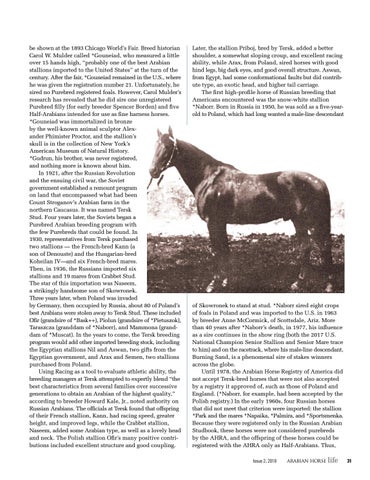be shown at the 1893 Chicago World’s Fair. Breed historian Carol W. Mulder called *Gouneiad, who measured a little over 15 hands high, “probably one of the best Arabian stallions imported to the United States” at the turn of the century. After the fair, *Gouneiad remained in the U.S., where he was given the registration number 21. Unfortunately, he sired no Purebred registered foals. However, Carol Mulder’s research has revealed that he did sire one unregistered Purebred filly (for early breeder Spencer Borden) and five Half-Arabians intended for use as fine harness horses. *Gouneiad was immortalized in bronze by the well-known animal sculptor Alexander Phimister Proctor, and the stallion’s skull is in the collection of New York’s American Museum of Natural History. *Gudrun, his brother, was never registered, and nothing more is known about him. In 1921, after the Russian Revolution and the ensuing civil war, the Soviet government established a remount program on land that encompassed what had been Count Stroganov’s Arabian farm in the northern Caucasus. It was named Tersk Stud. Four years later, the Soviets began a Purebred Arabian breeding program with the few Purebreds that could be found. In 1930, representatives from Tersk purchased two stallions — the French-bred Kann (a son of Denouste) and the Hungarian-bred Koheilan IV—and six French-bred mares. Then, in 1936, the Russians imported six stallions and 19 mares from Crabbet Stud. The star of this importation was Naseem, a strikingly handsome son of Skowronek. Three years later, when Poland was invaded by Germany, then occupied by Russia, about 80 of Poland’s best Arabians were stolen away to Tersk Stud. These included Ofir (grandsire of *Bask++), Piolun (grandsire of *Pietuszok), Taraszcza (granddam of *Naborr), and Mammona (granddam of *Muscat). In the years to come, the Tersk breeding program would add other imported breeding stock, including the Egyptian stallions Nil and Aswan, two gifts from the Egyptian government, and Arax and Semen, two stallions purchased from Poland. Using Racing as a tool to evaluate athletic ability, the breeding managers at Tersk attempted to expertly blend “the best characteristics from several families over successive generations to obtain an Arabian of the highest quality,” according to breeder Howard Kale, Jr., noted authority on Russian Arabians. The officials at Tersk found that offspring of their French stallion, Kann, had racing speed, greater height, and improved legs, while the Crabbet stallion, Naseem, added some Arabian type, as well as a lovely head and neck. The Polish stallion Ofir’s many positive contributions included excellent structure and good coupling.
Later, the stallion Priboj, bred by Tersk, added a better shoulder, a somewhat sloping croup, and excellent racing ability, while Arax, from Poland, sired horses with good hind legs, big dark eyes, and good overall structure. Aswan, from Egypt, had some conformational faults but did contribute type, an exotic head, and higher tail carriage. The first high-profile horse of Russian breeding that Americans encountered was the snow-white stallion *Naborr. Born in Russia in 1950, he was sold as a five-yearold to Poland, which had long wanted a male-line descendant
of Skowronek to stand at stud. *Naborr sired eight crops of foals in Poland and was imported to the U.S. in 1963 by breeder Anne McCormick, of Scottsdale, Ariz. More than 40 years after *Naborr’s death, in 1977, his influence as a sire continues in the show ring (both the 2017 U.S. National Champion Senior Stallion and Senior Mare trace to him) and on the racetrack, where his male-line descendant, Burning Sand, is a phenomenal sire of stakes winners across the globe. Until 1978, the Arabian Horse Registry of America did not accept Tersk-bred horses that were not also accepted by a registry it approved of, such as those of Poland and England. (*Naborr, for example, had been accepted by the Polish registry.) In the early 1960s, four Russian horses that did not meet that criterion were imported: the stallion *Park and the mares *Napaika, *Palmira, and *Sportsmenka. Because they were registered only in the Russian Arabian Studbook, these horses were not considered purebreds by the AHRA, and the offspring of these horses could be registered with the AHRA only as Half-Arabians. Thus, Issue 2. 2018
arabian horse
life
31
